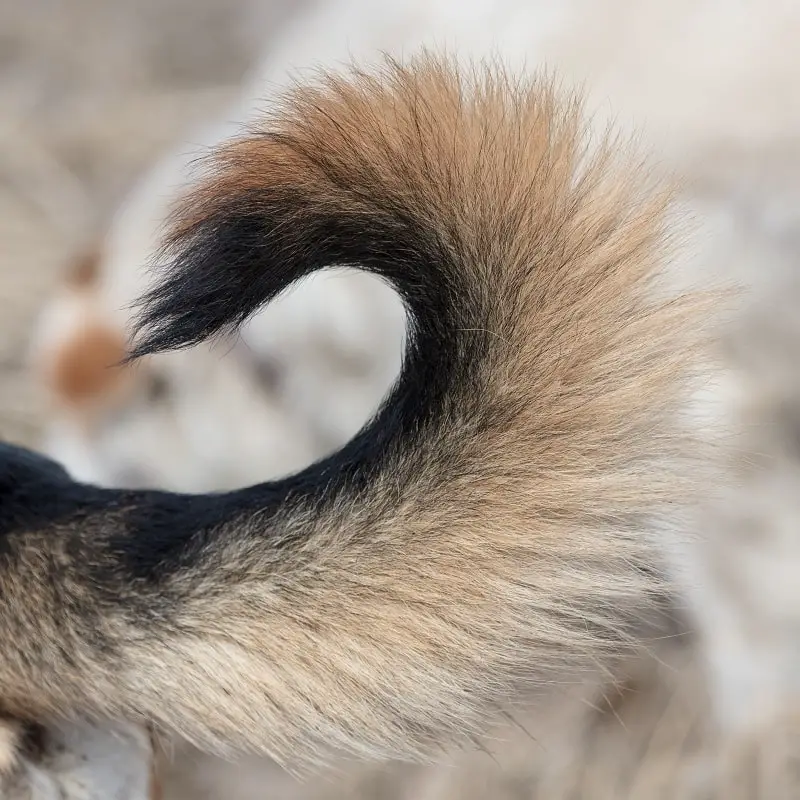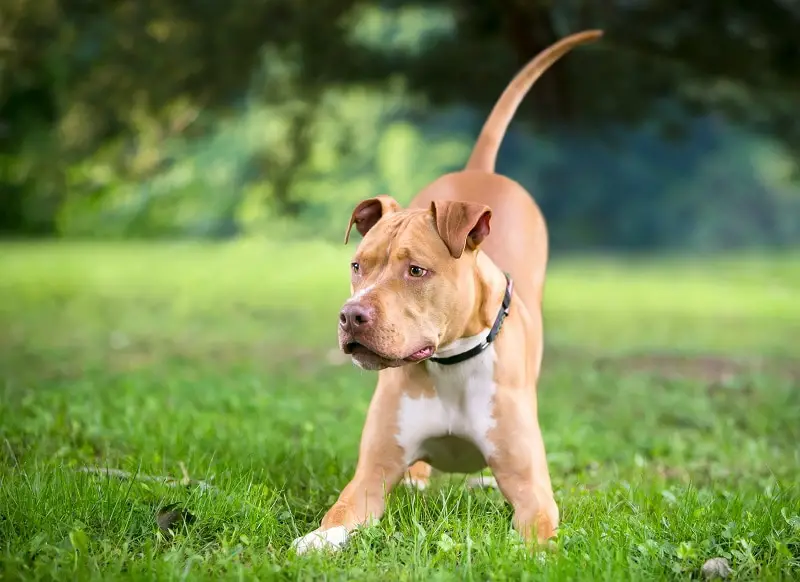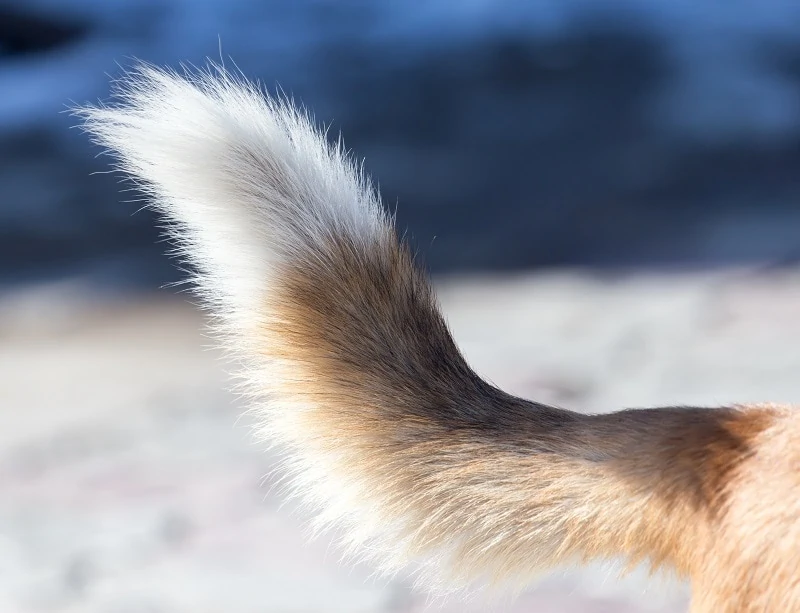Did you know that dogs use their tails to express feelings and communicate with people and other canines? But while most people believe that a waggy tail equals a happy dog, there’s more to tail-wagging than it meets the eye.
Why do dogs wag their tails? Dogs wag their tails to express a wide range of emotions, including happiness, excitement, nervousness, or aggression. Energetic tail wagging means that a dog is happy and excited to see you. But, a tail tucked between the legs is a sign that a dog is afraid, anxious, or submissive.
In this article, we’ll tell you why dogs wag their tails and what does a wagging tail means, among other things. Keep on reading if you want to find out more!
What Does A Wagging Tail Mean?

Since dogs don’t know how to speak, they use body language and tail wag to communicate with people and other canines (source). Most people think that dogs wag their tails only when they are happy, but that’s not really the case.
Besides feeling happy, a dog wagging its tail can also feel nervous, threatened, anxious, excited, or submissive. The best way to understand the “tail wag” is to pay attention to your dog’s entire body language, including facial expressions, stance, and ears.
Dog Tail Signs and Positions

Most dogs are born with tails, but the natural position of a dog’s tail varies from one breed to the next. For example, Pugs have tails that curl upwards, but many other breeds including Beagles hold their tails vertically in a natural position.
Since natural tail position can vary depending on the breed you’ll need to observe your dog to figure out what his natural tail position is. When you figure out how your dog is holding his tail while relaxed, you’ll easily spot all other positions.
Take a look at the hidden meaning behind different tail positions:
Natural Position, No Wag
For most dog breeds, a natural tail position is when the tail hangs down near the heels, but it isn’t tucked under. When a dog is holding his tail in this position (not too high or not too low) it means that he is relaxed and completely at ease.
Keep in mind that the neutral position varies and will look different in dogs with curly, stiff, and broad tails.
High, Wagging Tail
A high tail that’s wagging fast is usually a clear sign that a dog is aroused or excited. You’ll get a better idea of how your dog is feeling by looking at his entire body language and the situation you are in.
Backward, Gentle Wagging
When a tail moves from a neutral position to a slightly lower one, it means that the dog is feeling insecure. And if a dog is also gently wagging his tail, he is probably unsure what to do in that particular situation.
Generally, dogs do this type of shy tail wag when they are meeting new people or other dogs, but aren’t completely sure if they should approach or bolt.
Tail Between Legs
A tail that is lowered and tucked between the legs usually indicates anxiety, fear, or submission. By tucking his tail between his legs a dog is minimizing his scent and showing that he is not a threat to other dogs and people.
Proper socialization can help your dog to overcome his fears and become more confident when meeting other dogs and new people (source).
Big Wags
When a dog is wagging his tail energetically from side to side, it means that he is happy. A big tail wag can also mean that your dog is glad to see you, especially if he is also trying to lick your hands or if he wants to play.
Vertical Tail
If a tail has gone from a neutral into a vertical position or is arched over the back, tread carefully, since this is the sign that a dog might get aggressive. The higher the tail is raised, the greater the chance that the dog is going to attack.
With a high tail position, the dog can release more of his scent through anal glands which tells other dogs that he is marking his territory or preparing for an attack.
Wagging Speed Indication
The speed at which the tail is moving is another communication tool and can give you a better idea of a dog’s thoughts and actions. The rate at which dogs move their tails can point to:
Excitement
The faster a dog wags his tail, the more excited he is. An excited tail wag can range from slow with broad sweeps or extremely fast when a tail moves in circular, helicopter-like motions.
Some dogs get so fired up that they start wagging their tails so fast that it might seem like the entire tail is vibrating with excitement.
Insecurity
A slight movement of the tail can indicate that a dog is feeling insecure and not entirely comfortable. Most dogs will only slightly move the tip of their tails when they are hesitant about meeting new people or other dogs.
Friendliness
A friendly and relaxed dog will wag his tail freely in broad circular motions. Depending on how excited the dog is to see you, the wagging can become even faster and is a good indication that the dog is happy (source).
Aggression
When a dog starts wagging his tail fast while holding it high it means that he can become aggressive very fast. When dealing with an aggressive dog you should do everything in your power to appear less threatening, so try to remain calm and avoid direct eye contact.
Note, besides tail position and speed, the direction of tail wagging is also an important cue to how a dog is feeling. Studies show that dogs wag their tails to the left side when they are frightened, and to the right side of the body when they are happy.
The left side of the brain controls movement on the right side and is associated with positive feelings, like love and happiness. Therefore, the left side of the brain is engaged when a dog is happy, and he will wag his tail to the right.
On the other hand, the right side of the brain is associated with negative feelings, so a frightened, anxious, or aggressive dog will always wag his tail to the left.
The Importance of Understanding Dog Tails
Despite common beliefs, dogs wag their tails to express an array of different feelings, besides happiness. Depending on the position and the speed of the wagging, a tail can indicate that a dog is scared, aggressive, frightened, or intimidated.
Just because a dog is wagging his tail, it doesn’t mean that he isn’t going to bite you! However, knowing tail positions and canine body language can help you to understand and interact with dogs in a safe way.
Conclusion
It’s a common misconception that dogs wag their tails only when they are happy. The truth is, dogs use their tails coupled with other body language cues to express a wide range of emotions.
A wagging tail can be a good indication that a dog is happy, but it can be a sign that a dog is feeling anxious, submissive, excited, nervous, or aggressive. Remember, dogs also use the rest of their body to communicate, so pay attention to all other cues to understand what your dog is trying to say.
Related Articles:


0 Comments